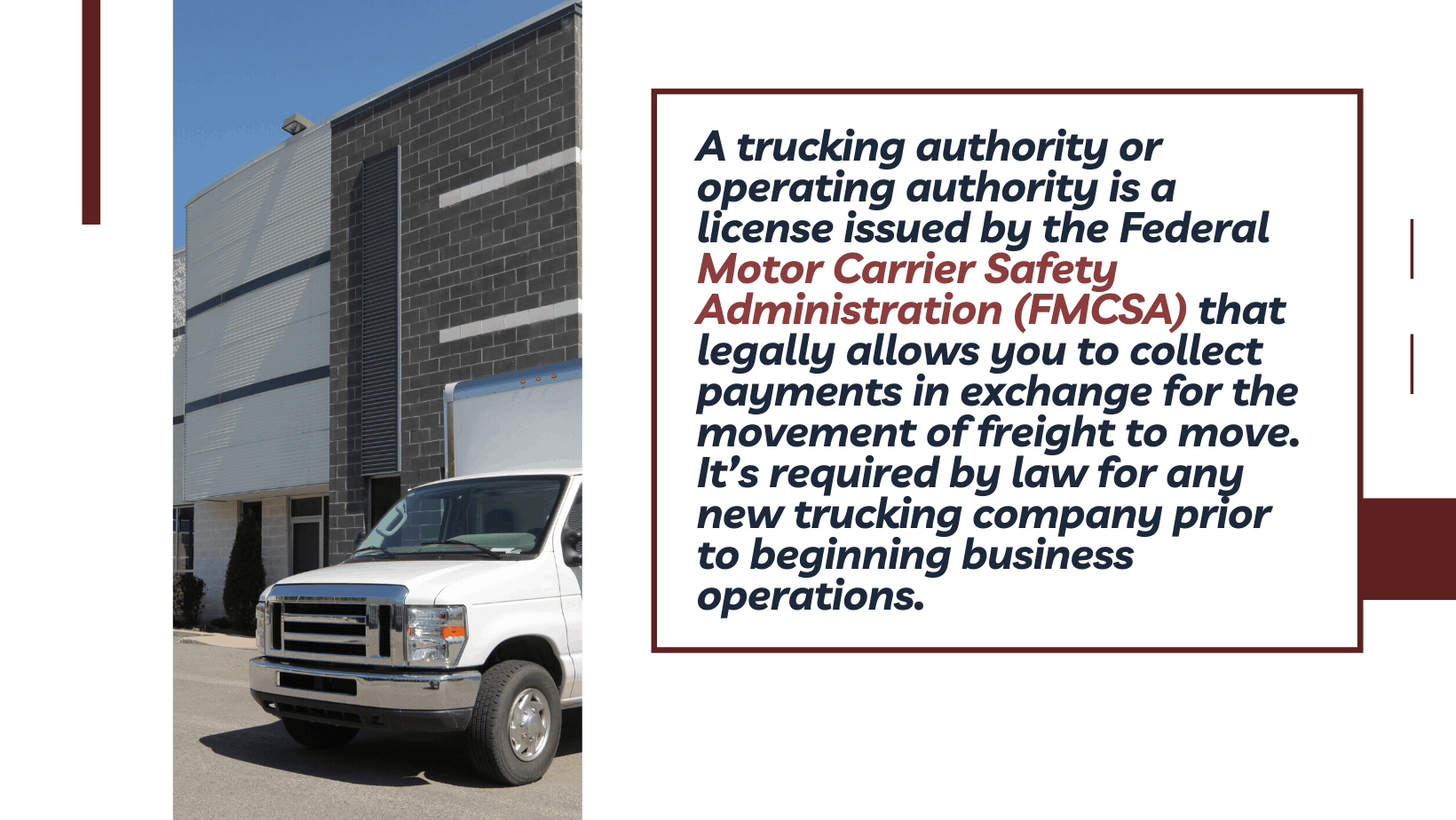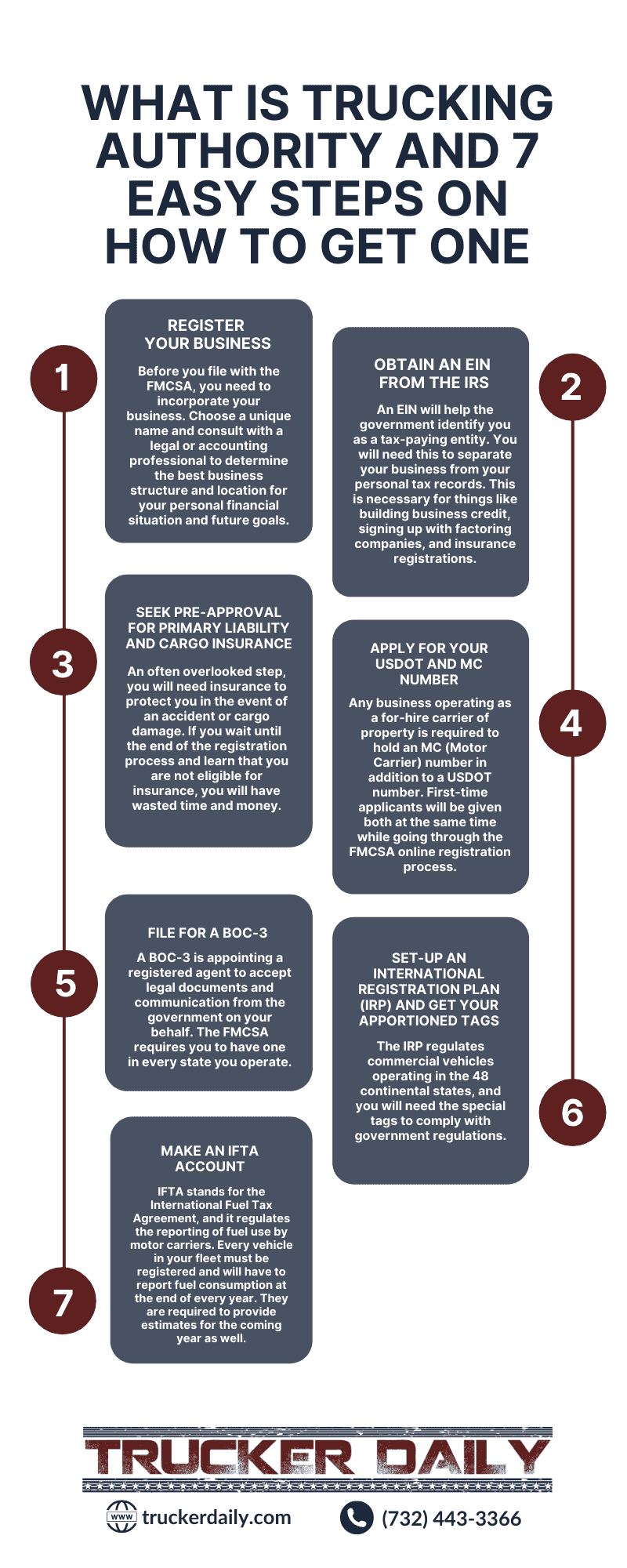If you are a company driver with dreams of going off on your own, the first step is learning all of the steps in filing for your operating authority with the government.
Here's a list of action steps to get your trucking authority:
- Register Your Trucking Company: Complete the necessary paperwork and register your trucking company with the appropriate state agencies. This establishes your business entity and ensures compliance with local regulations.
- Obtain an EIN: Apply for an Employer Identification Number (EIN) from the Internal Revenue Service (IRS). This unique identifier is used for tax purposes and is required for your trucking operations.
- Get a USDOT Number: Apply for a USDOT number through the Federal Motor Carrier Safety Administration (FMCSA). This number serves as a unique identifier for your business and is required for interstate transportation.
- Apply for an MC Number: Depending on the type of operation, you may need to apply for an MC (Motor Carrier) number from the FMCSA. This number is necessary for interstate commerce and must be obtained if you plan to transport goods across state lines.
- File a BOC-3 & Obtain Insurance: File a BOC-3 (Designation of Process Agents) form with the FMCSA to designate process agents in each state where you operate. Additionally, secure an insurance policy that meets the FMCSA's minimum requirements for liability and cargo coverage.
- Pay HVUT: Fulfill your Heavy Vehicle Use Tax (HVUT) obligations by submitting Form 2290 and paying the annual tax for vehicles with a gross weight of 55,000 pounds or more. This tax is collected by the Internal Revenue Service (IRS) and is required for operating heavy vehicles on public highways.
- Set up IRP and Apportioned Plates: Establish your International Registration Plan (IRP) account to apportion the registration fees for your commercial vehicles across multiple jurisdictions. This allows you to obtain apportioned license plates, enabling your vehicles to operate in multiple states.
- Create an IFTA Account: Set up an International Fuel Tax Agreement (IFTA) account to simplify fuel tax reporting for your commercial vehicles. This agreement streamlines the calculation and payment of fuel taxes when operating in multiple participating jurisdictions.
By following these steps, you can navigate the process of obtaining your trucking authority and ensure compliance with the necessary regulations. Keep in mind that requirements may vary by state, so it's essential to consult with the appropriate agencies and professionals to ensure you meet all the necessary obligations for your specific situation.
While the steps to acquiring your own authority are straightforward, requirements can change based on what kind of trucking business you are looking to operate.
In this article, I’ll cover everything you need to know about getting your own trucking authority, from the different types of carrier authorities to the steps to getting one which will help you decide if it’s the right business move for you.
Is it better to get your own trucking authority?
Getting your own operating authority means going into business for yourself. So getting your own trucking authority is better since you are now becoming an independent owner-operator.
It’s a huge career change and can give a driver growth opportunities in terms of freedom and earning potential that just isn’t available if you’re driving for another company.
The benefits of having your own trucking authority are:
- Increase in Pay
Getting your authority legally allows you to accept freight from anyone you choose. For most drivers, this means cutting out the middlemen involved in the load acceptance process, which puts more money in your pocket as a driver.
Owner-operators no longer need to rely on brokers or trucking companies taking a cut on their loads. Instead, you get paid 100% of what you earn.
- Increased Freedom
Operating for yourself gives you complete control over how your business is run. You choose how often you go home, which lanes you run in and who you work for.
Drivers who go into business to work for themselves may find themselves more excited about their work and ultimately more productive.
- Unlimited Growth Potential
Owning your own trucking authority gives you access to growth not available in any other driving arrangement. Since you have the ability to make decisions for the business, you have the opportunity to hire drivers to operate under your authority.
You can do this by “leasing on” other owner-operators or by acquiring your own trucks and hiring drivers that you can control.
Speaking of acquiring your own trucks, dry vans are some of the common types of trucks you will see on the road. If you’re thinking of venturing into dry van trucking, we made just the exact guide you will need. Just click the link to access it.
Leasing on an owner-operator simply means that another driver will supply the truck and trailer, but you as the business owner will supply the government registration and insurance requirements that allow them to operate legally.
No matter what growth structure you choose, when done right, you can slowly transition from active driver to trucking company CEO and eventually run the whole business from an office.
Still unsure whether starting a trucking business is for you? Check out this Trucker Daily article which weighs the pros and cons of running a trucking business.

Different types of trucking authority & how to choose the right one for you
There are a few different types of operating authorities, so choosing one that is right for you depends on what kind of business you want to start and the types of loads you want to haul.
According to the FMCSA website, there are 2 types of carrier authorities that can authorize you to haul different types of domestic freight.
- Motor Carrier of Property (except Household Goods)
A motor carrier of property is licensed to transport regulated commodities in exchange for payment. These carriers are NOT permitted to transport household goods between residences.
Example: Any trucking company that exclusively handles business-to-business freight.
- Motor Carrier of Household Goods
A carrier of household goods is authorized for hire by the general public to transport household goods in exchange for payment. A household good is defined as any personal item that will be used at home.
This includes goods being shipped from a factory to a retail store if the goods are purchased with the intent to be used in a home and transported at the request of the householder who pays for the transportation charges.
Example: Any standard moving company.
If you're interested in becoming a middleman, the FMCSA also grants brokers of property authorities.
This gives you the right to accept payment for freight moves and subcontract other truckers to drive on your behalf.
Trucker Daily's Recommendation:
If you are trying to decide which operating authority is right for you as a driver, we recommend starting as a motor carrier of property.
Household good moves involve another level of liability since you are heavily involved in the transport of the general public's personal effects.
Household goods carriers typically have a very hands-on role in loading and unloading their trucks, whereas property-only carriers enjoy the benefits of no-touch freight.

How much does trucking authority cost?
The cost to obtain a motor carrier authority is $300, which covers the filing of the paperwork and issuing your MC and USDOT numbers. Keep in mind that there are other fees associated that we can't predict like your other registrations, your insurance, driver's license fees and of course the cost of your equipment.
How long does it take to get an operating authority?
Getting an operating authority can take between 6-8 weeks.The process from beginning your application to finalizing your authority can be a lengthy one. This timeline already includes incorporating your business, registering your BOC-3, filing with the FMCSA and getting the necessary insurance and tags.
You can shorten this timeline by keeping organized records and having all of your information accessible for any agency that requests it. Mistakes to your application can force you to refile and start from the beginning which can set you back 8-10 weeks.
Your registration won't be granted until the FMCSA can verify your proof of insurance coverage, and your BOC-3 application is submitted and approved.
Make sure you factor in this downtime during the planning stages of getting your own authority. Expect to be down and out of service and make sure you have a plan in place to supplement your lost income to support yourself and your family.
Are there any registrations specific to other states?
You will satisfy the requirements to operate in a majority of states with the basic filing steps we outlined above. However, there are a few states that need additional licenses and registration requirements in order to operate in those states.
Kentucky - The state of Kentucky requires you to register a KYU number if you are hauling a truck/trailer exceeding 59,999 pounds. You will be required to send quarterly reports to the State of Kentucky after you register for this permit.
New York - New York requires all vehicles with a gross vehicle weight exceeding 18,001 to obtain and keep a Highway Use Tax permit on file. New York will use the mileage and weight you report to the state to assess the quarterly taxes you owe.
New Mexico - Carriers exceeding 26,001 pounds in New Mexico are required to obtain a New Mexico Weight Distance Tax permit. New Mexico will assess taxes for this designation quarterly. The amount owed is based on the miles traveled within the state.
Oregon - Oregon has a strict system for reporting mileage within the state. Carriers hauling in the state of Oregon are required to submit a $2000 deposit or bond. The bond is returned to a carrier after verifiable compliance for the first 24 months of operation. Once registered carriers must submit monthly mileage reports to the state.
These state specific registrations are easy to apply to but require a great deal of diligence on the back end. Carriers must carefully track their operations in those states as mistakes can add up to costly overpayments or penalties for underpaying.
Do you need to hire a service to help get your trucking authority?
Though not necessary, there are plenty of third party services that you can hire to help you with the registration process. Typically you will be responsible for filing your initial incorporation documents and supplying all of the requested information.
You will also be required to fill out a power of attorney authorizing your chosen firm to act and communicate with the FMCSA on your behalf.
Once an application is in process you can not change the point of contact, so if it is already submitted you will be required to see it through on your own.
